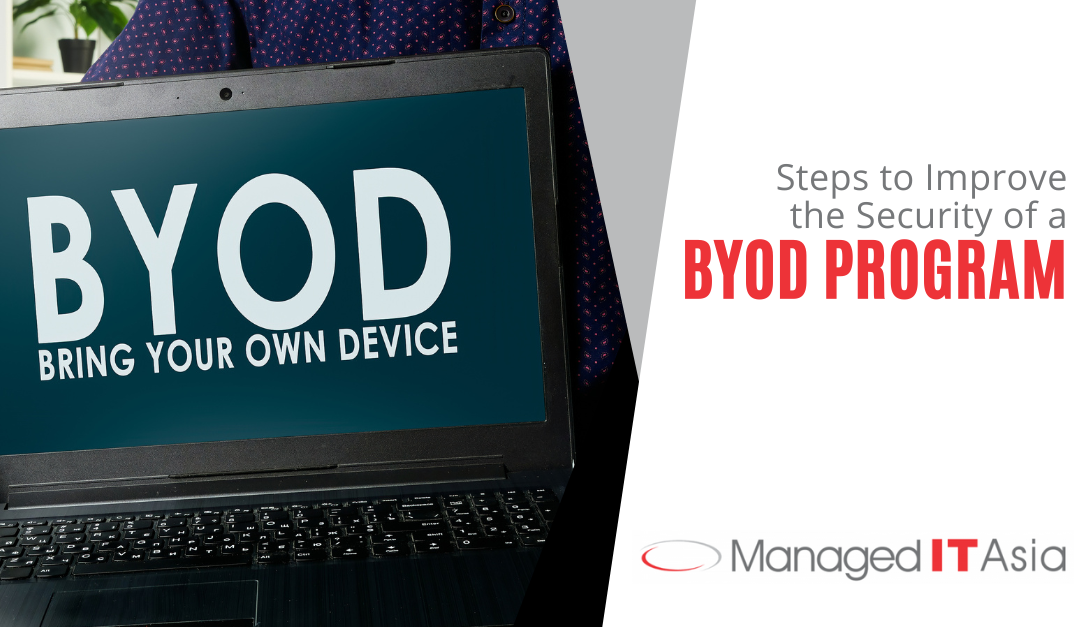Companies employing IT policies and tools have transformed numerous sectors in various world economies. Advancements like the Internet of Things (IoT) have allowed these company operations to blossom, especially for small businesses. One common IT policy is BYOD, which stands for Bring Your Own Device.
Mobile technology is now a mainstay in offices and critical to the workflow of most employees. Allowing employees to bring their own devices into the workplace for business helps organizations lower hardware and service expenses and increase work output and quality. However, BYOD security is becoming an issue for big, medium, and small corporations. How? This is because, to be effective, businesses must be able to maintain some level of control over employee-owned devices such as cellphones, tablets, and laptops. BYOD security strategies and policies are becoming widely implemented and accepted by businesses and their employees due to the rise in IT security failure, especially in BYOD applications.
How Far Can BYOD Go?
According to a recent study, the BYOD market will be worth over $365 billion by 2022, which is a great plus considering the fact that it hit $94 billion in 2014. What’s more, it is projected to hit record highs before 2026. Currently, 74% of businesses plan to onboard BYOD policies, including businesses that have already implemented BYOD. Increases in the application of the hybrid concept of work by more businesses and attempts to curtail security risks are driving factors in the rapid growth of bring-your-own-device applications.
Is BYOD For or Against You?
While the COVID-19 pandemic helped establish the hybrid and work-from-home culture, it also accelerated the action of staff using their own devices to access work-related apps. This heralded a different form of hack attacks and left IT staff scrambling to protect confidential company files and processes from attacks initiated by BYOD loopholes. Also, recent research found that 64% of employees use personal devices for work, but just 43% are properly enabled with security. As such, businesses that choose to overlook the usage of personal devices may be increasing the chances of being hacked. Hence, businesses can either embrace BYOD by implementing security measures to make the practice safer or prohibit BYOD completely and enforce it. However, the popular recommendation is that businesses embrace the BYOD trend and capitalise on its benefits, such as enhanced employee productivity and greater employee satisfaction via improved work-life balance. Simultaneously, they should employ security measures through company staff or IT outsourcing that can, to a high degree, limit the chances of BYOD-caused attacks. So, here are some steps to improve the security of your BYOD program:
All BYOD devices must be passworded
Many people opt to neglect this, even though it is the first line of defense against data theft. Why? Because it is seen as too obvious! However, enforcing the usage of passwords on all BYOD devices is very effective in limiting access to company data. Utilized passwords should be lengthy, unique, and random and should be different for each device. Easy-to-guess passwords are the dreams of hackers – all it takes to get past them are brute force assaults. The shorter the password, the faster a brute force assault can be used to go through. Multi-factor authentication, which requires workers to supply two distinct pieces of information to prove their identity, adds another degree of security. The first factor in most systems is a strong password, and the second factor can be a second password, code, fingerprint, or face recognition.
Back up data
Well-designed BYOD strategies help reduce the chance of a security breach, but should there be a breach, you must have backups ready. Ensure you back up your data to off-site servers and the cloud to guarantee that any device data can be restored fast after an attack.
Highly accessible BYOD manuals
BYOD policies are not made to be placed inside drawers. Rather, they should be as accessible as possible for quick and repeated assimilation. Signs and messages that teach these policies should be placed at specific locations at work and sent as reminders to every staff consistently. Justifications should be made for external office usage. However, there should be a balance – policies should also have staff in mind regarding productivity, device usage, and privacy. Unrealistic regulations could cause staff unhappiness and lower productivity.
Schedule Regular Device Updates
Company IT staff should constantly remind other staff of the need to update their devices consistently. Device manufacturers are continually upgrading their operating systems to fix any vulnerabilities. These updates are developed to ensure any latest loopholes are taken care of. Consistent mobile updates can help keep all devices in the network ahead of any dangers.
Let Managed IT Asia Help You with Device Security & BYOD
Looking to create a custom BYOD plan for your company? Managed IT has vast experience creating BYOD strategies, policies, and plans specifically curated for each company. Contact us today to get started!
MANAGED IT ASIA, we are an IT Support, IT Solutioning and Managed IT Service Provider specializing in serving Small Businesses across Asia. Call us at +65 6748 8776 and let us manage your Small Business IT today!
